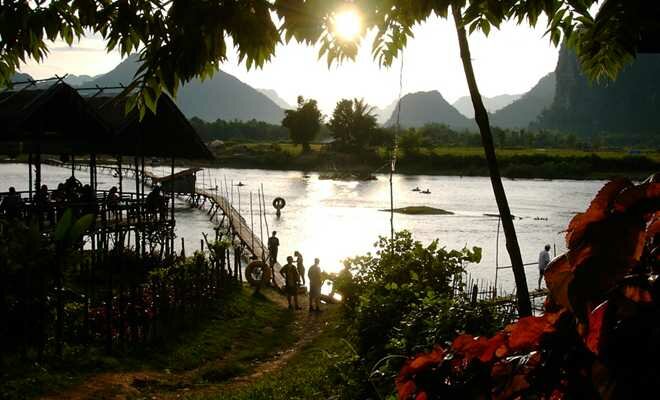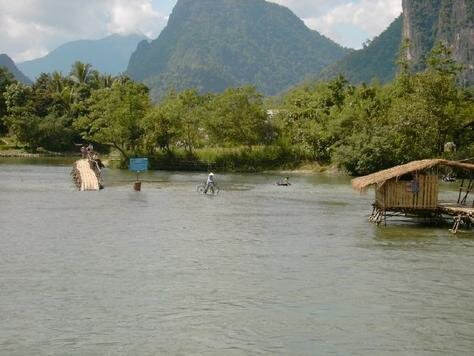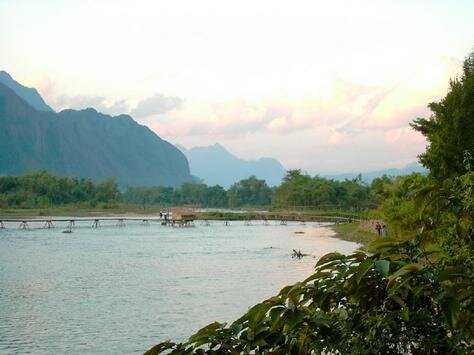Travel blogger Stephanie Yoder of TwentySomething Travel explains why she doesn’t miss this former “amusement park for western imperialism.” Find out why she will continue to visit – and why the past is nothing to write home about.
Ask any veteran backpacker in South East Asia and they will tell you it’s the end of an era. Vang Vieng, Laos, the former capital of party tourism in the region, a seven days a week blow out bash along the sleepy Nam Song river, is no more. The bars have been shuttered, the zip lines torn down and the drugs banished by the Laos government. The party is over.
Personally, I say good riddance.
I visited Vang Vieng in March 2011 at the height of the backpacker boom. The town’s reputation had proceeded it throughout the region in whispers and knowing glances, absurd stories and the ever-present “In the Tubing” t-shirts. For many people this seemed to be THE reason to visit Laos. Of course I had to check it out for myself.
I arrived on a dusty school bus packed with other backpackers. The formerly sleepy Lao village had all the hallmarks of a town grown too fast, crowded with guest houses, sunglass shops and pizza places. Cafes full of hungover twenty-somethings blared Family Guy and Friends re-runs on an endless loop
The main attraction for the thousands of shoe-stringers who flocked here each year was tubing along the river. Or, more accurately: getting completely wasted at the riverside bars that line the banks, luring backpackers with free shots and thumping pop music. The place was complete and utter lawless hedonism: $1 cocktails, “magic” mushroom pizzas, opium tea and more.
Heaven for backpackers? Maybe for some, but I left unimpressed. While I did enjoy eating some western food, tubing down the river and drinking a $3 bucket or two, I couldn’t get over the sleazy dubiousness of the whole place. I was relieved to hear about the changes made by the government. I know some backpackers must be reacting with indignation, but here’s why they are wrong:
First of all, tourists in Vang Vieng were literally DYING. Drowning, overdosing, breaking their necks on unsafe swings. Not just one or two either, almost 30 backpackers died in 2011. Tragically it seems that drugs, fast running water and zero safety precautions are not a safe combination. This alone is reason enough to shutter the insanity.
Secondly, I’ll get up on my soapbox and say it: this is BAD travel. Really terrible travel: western imperialism and sense of entitlement and a local hotspot grown totally out of control. People didn’t visit Vang Vieng because they were interested in travel, they simply saw it as an amusement park for rich foreigners.
I saw some of the worst kinds of tourists while I was in Vang Vieng. Laotians are a very modest people, yet young Australians paraded around in nothing but bikinis all day long. Spoiled kids threw trash on the ground, littered the river with beer bottles and were rude to the locals. Whatever local culture Vang Vieng might once have had has been destroyed and paved over with cafes that play Family Guy all day long.
Some will argue that the party crowd brought much needed business to the local economy. Yes, but at what cost? Laos is one of the poorest countries in the world, obviously the people there are going to earn whatever money they can get, but do you think it’s right that they have become reduced to drug dealers and party facilitators?
Finally, let me let you in on a little secret: Vang Vieng is still there. You can still visit. You can even still tube down the Nam Song, relax and take in the beautiful Karst mountains. There is trekking, rock climbing and caves to be explored, local villages, temples and an organic farm.
There is still plenty to see and do here. Without the massive drug and party culture dominating the town, they have a unique chance to reinvent themselves as an eco-tourism destination. Did you love Vang Vieng? Go support it now.

Stephanie is a girl who can’t sit still. Since graduating she has spent her time either roaming the earth or saving up for her next trip, until finally quitting the rat race for good to become a full time writer, blogger and owner of Twenty-Something Travel.
You can follow her travels on Google+ Twitter and Facebook








